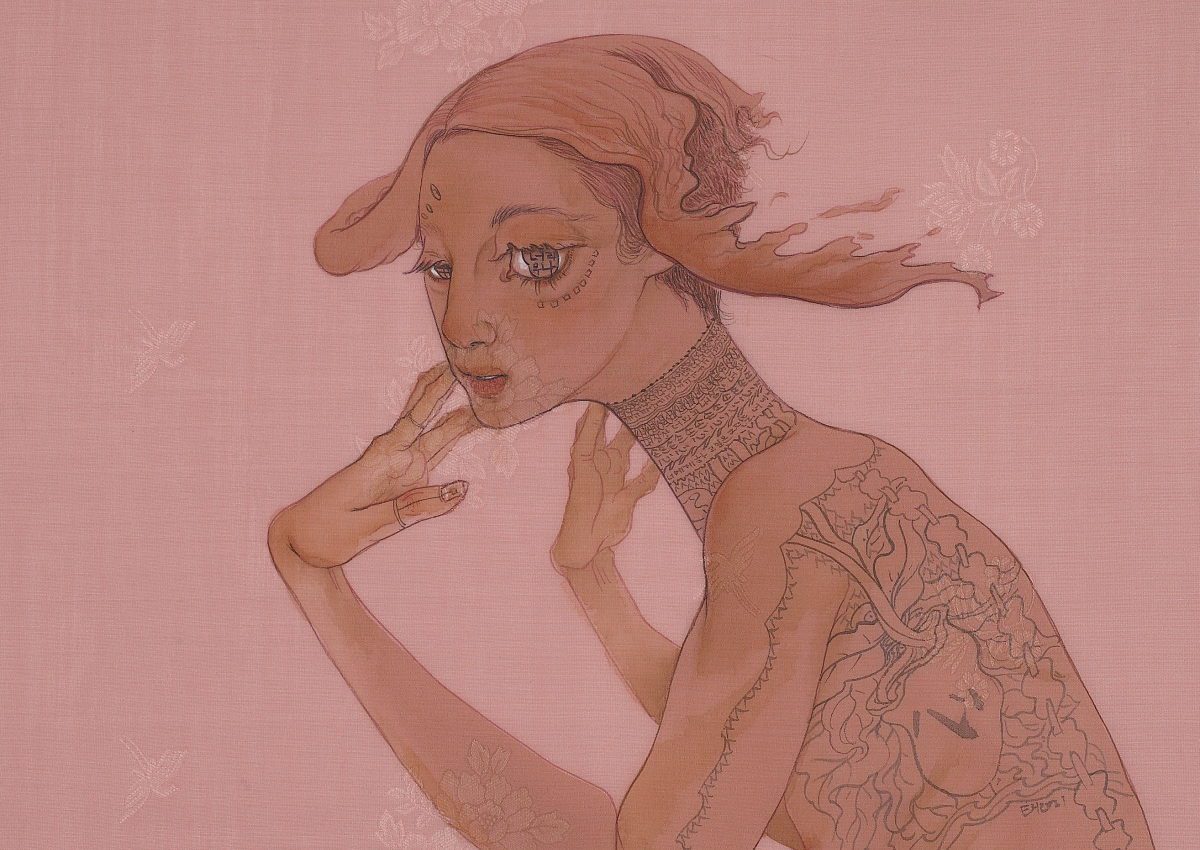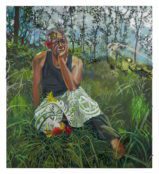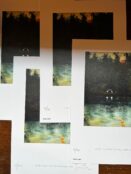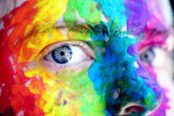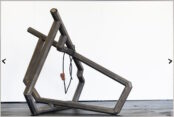Tae Kim paints the people she meets in online games. Winners and losers, these are the people she’s competed against and in their reactions she sees their humanity. In some disciplines of East Asian painting the soul is captured in an ecosystem of physical and metaphysical details, using the same perspectives and techniques Kim paints the souls of gamers via a palimpsest of cultural symbols, portraiture and speculative biology.
Tae Kim ( B. 1986) lives and works in Seoul, Korea. In 2010, Kim received her Bachelor’s of Fine Arts degree in Oriental Painting from the Seoul National University where she later studied for her Master’s degree in the same discipline graduating in 2013. In addition, in 2016 Tae Kim graduated with a Masters degree in painting from the Slade School of Fine Art, UK.
Her Solo exhibitions include Black Cow, Mythtake Museum, Gapyeong (2021); Player Like You, The Cheong-ju Art Studio, Cheong-ju (2021); Moist Touch of Ping, Gallery DOS, Seoul (2020); Compulsive Hyperlink, Art Space ‘Plasque’, Seoul (2019); Perpetual Interchange, Inyoung Gallery, Seoul (2019); Indecipherable skin, Just365projectspace, Seoul (2017); Living Templates, Gallery DOS, Seoul (2014); The Revived 12 Gods, Year 2013, Topohaus, Seoul (2013); Division/Divinity, Insa Art Center, Seoul (2011). Represented by Kristin Hjellegjerde Gallery and ahead of her <Faceless Gamers> (March 26th – April 30th 2022) exhibition Trebuchet interviewed (the full article on Kim appears in Trebuchet 11: process) Tae Kim to discuss how she perceives the soul in the limitations of online interactions.
How do you choose your subjects?
Well, they need to be on my friend list. Or people who I played online, or together, I will have a log of them. I’m a hoard data holder as well. I basically hoard everything. The way I process choosing a person or making a claim to the person is if I have a game experience or any online experience that actually makes me want to paint them. Then, I will either take a screenshot or just ask them ‘Can I interview you’?
Do you record all your games?
Sometimes, but mostly these days I’m playing League of Legends which is a quick battle game. So, mostly I rewatch the replay game, or download my playing status online. But those things will be in the presentation.
It’s quite interesting because, they have this whole worldwide idea and each character has a very, very dynamic storyline with life and death, dying and revenge. Every character has them and they have 160 Something characters within it. It’s like a Game of Thrones situation.
What is the logic behind the titles of your work?
The work that you’re seeing now on the KHG website is from the summer show, and those are titled after how we measure a person’s worth in games and online culture. If the person has a ‘one’ that means they are a person of worth within the game. If you’re under 0.8, that means that person is actually not helping. I was actually questioning the value of a person within the virtual world. The bottom liner, or top liner, those describe their working situation, that way, you have a top liner, mid liner, jungler, a healer/supporter in the game, but I was just thinking about this within a fantasy world where everything is possible.
We are all doing the same thing as we were taught and learned within the actual society. Though you’re in a place where physical demand is not present, it’s possible to do everything, but at the same time you are doing what you are trained to do. Which is to compete with people and measure people by numbers and how they do it, which is just statistics. That was the baseline for that series of works.
Does that theme run through all your work?
It’s a general undercurrent. I used to have a series called Black Cow (2019-2020), which is a mean word for a stupid person who uses too much money or time within the game. That’s the primary meaning of the term and my undercurrent of how sad and tiring this whole thing of can be within this ideal place with all these lovely cultures and possibilities of cultures.
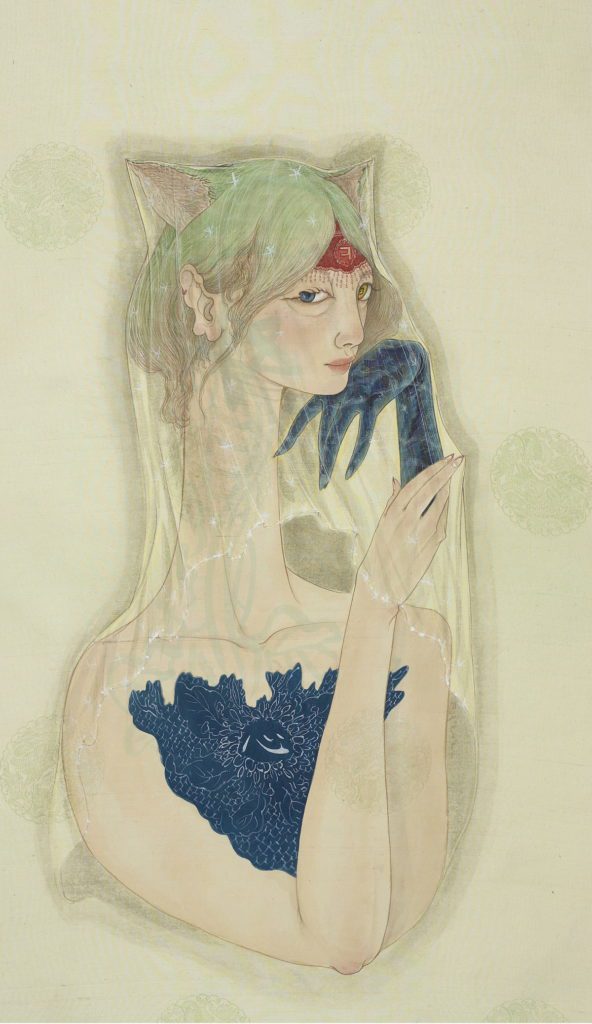
Is there an aspect there that you’re satirising or at least commenting on Korean/Global culture of us doing things repetitively and the unhappy repetition of point scoring?
The whole motionless or expressionless faces are a symbol of technology’s limited ability to genuinely express someone’s feelings. Something that we have to use emojis, text, or characters to convey. So, even though you are contacting and having an exchange it is not the same as a real life experience. That would be number one. And the second thing would be if you look at all of my paintings, they will either have very slight wrinkles or dots or imperfections. I’m thinking about the multi personalities or multiplayer personalities that people have developed. Perhaps they could become that ideal thing. Where the ideal part of themselves via Games or IDs in the hyperconnected society. Unlimited through these ideal things and yet driven by a limited person, which reveals their true character. Even now, it is beautiful though it’s limited in a way. In a sense, it’s a memento mori that you have to go back to the physical world.
The paintings emphasise the physical, vein structures, vegetal people, almost quasi aquatic in places. Are these things symbolic in classical Korean culture?
I’m a professional replica artist for museums and I love the idea of the Eastern Asian idea of the soul and how it is captured within a figure. Which is the essence of Korean Chosun Dynasty portraiture. Along with the idea that you have to make everything right. You have to make the beards correct, even little dots of the faces, if it’s wrong, that person is not in the painting. What I’m interested in is painting from a world where I can’t see the person I am having a deep relationship with. So, how can I measure and capture that person within a painting? That is the challenge and the reason why I’m using these portraiture methods to explore a new way of connecting with people. I’m of the first generation of people who grew up with the internet, and most of my friends are those I’ve met online.
Also, I am very interested in early 1900s where in Japan and in Korea the Western influence came in from the Netherlands. Specifically, how medical science books came in, and contrasted with the way that we see our body. From the Western medical awareness the person’s soul isn’t really located. Is it in the functional brain or is it in the heart? This is why you will see a lot of hearts with Chinese character for ‘heart’ on it. I’m just questioning where our soul is within a culture when every culture is able to be meshed together within the internet world.
My paintings have many references to Eastern Asian ideas of bodies. We have this whole cultural understanding that you cannot open the body to know how it functions. In Eastern Asian medicine, we believe that each functioning body has a cycle of its own. If you open up that person to explore how it works it is not working because the energy system has been cut.
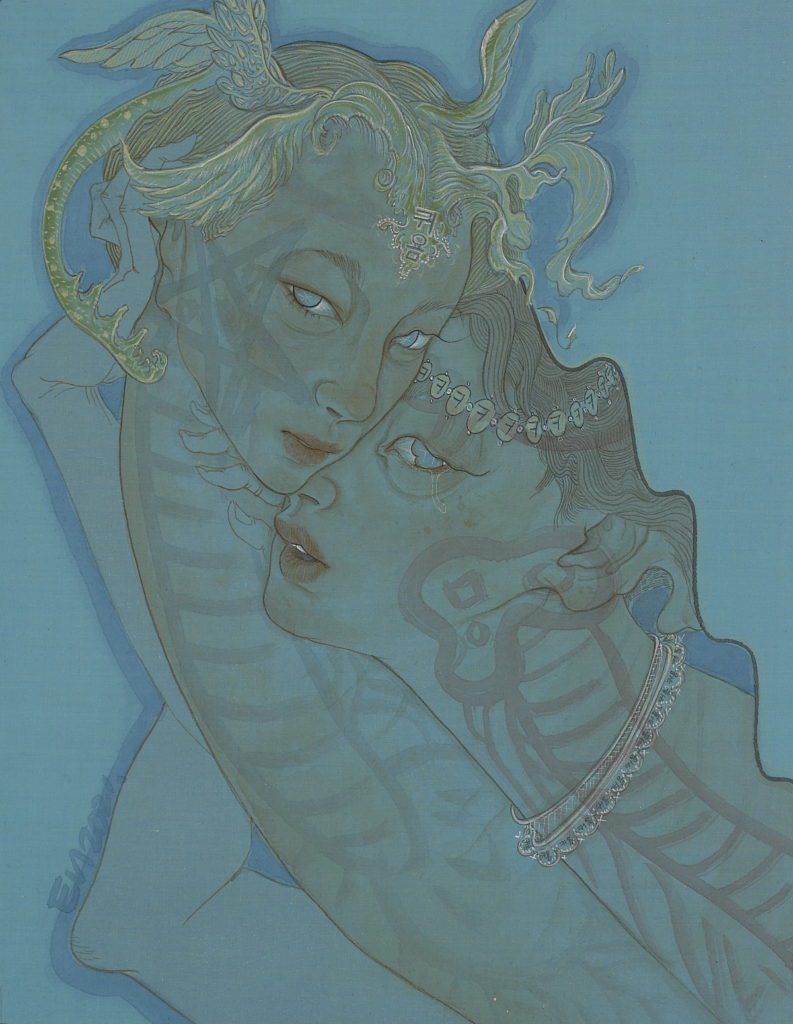
That’s the reason why all of the paintings that I do have those medical systems on them, you’ll see it in all of my paintings. I’m showing a functioning person, but it’s a new concept of a human. I’m not a post human artist really but more of trying to capture the transhuman state of a physical body that is trying to locate where it is within the internet world. I’m showing a person who is alive and functioning, but if I open them up and try to see them without their force or context, they will die. This is my perception of the hyperconnected person.
Those works were actually done in 2018. I had a whole series from 2018 to 2019, about these energies. About how we are alive via the social connections we have and that within this (social media culture), we have to be connected by somebody to be alive. And that was my main theme for 2018 -2019.
In terms of the political side, I suppose my works have a bit of satire within them even from 2009. But it’s a satire in the way that I conceive of society. I don’t have an agenda. Moreover, I feel I’m an observer of this new species of people. And I don’t know how they’re functioning. So, at this moment I would call myself more of an observer.
Do you collaborate with other artists?
Not at the moment, because painting is such a solo work the opportunities are not that open, but I’m always open to work with others. And I have a couple of works that I want to do. And it’s on the process of making interactive paintings (borrowed skin). I’m talking about physical limitations in a world where young gamers and old gamers and their physical limitations.
Also, I have this concept of borrowed skin. Where we use borrowed characters to use within online culture. I’m referring to how we change clothing as humans. I’m going to do that with a video artist as well. I’m doing a lot of stuff. I’m a hoarder. I hoard everything.
What’s the symbolism of the long necks?
I was looking for new physical terminologies or changes that happened physically within the past couple of decades. Apparently, there’s a syndrome called the turtle’s neck, where your neck becomes elongated, because you’re looking down too much at your phone. I have it as well. The long neck is a reflection of that of this (technology) changing the human body.
It’s the state of transhumans, your inner self is your inner IDs that already has diversified with multiple personas and different IDs and hyperconnected personalities? Well, that’s how your physical body actually is? Or is it? Or is your physical body your being? Perhaps we’re technological beings now trying to catch up but because it’s still based in the physical? It’s slow but I feel it’s catching up. Transhumanism is definitely one of my hashtags.
How are you embracing transhumanism?
For me, writers like Katherine Hayles, Kim Seonhoe are interesting because I think post-humanism isn’t gonna be possible because the physical body is always needed to form an identity. However, identity itself is diverse. I’m still focused on the fact that we’re still appreciating the body, the textures, the fields and the other things that the body can do. But at the same time, I feel there’s a new whole race emerging who can actually understand and embrace a whole world that is neither physical nor relies on the physical.
I work with the idea that for certain identities to function you need a physical self or something solid, that comes through with my dakimakura work which are giant pillows. I make dakimakura (Daki means to hug and Makura means pillow in Japanese) pillows that you can touch. Dakimakura are hugging pillows that Otakus (a person obsessed with online sub-culture) make in the shape of a celebrity or anime character that they want to hold. For me it’s interesting that it’s totally about how they love a person in 2d but have to have them physically. They want to hug somebody and that’s human nature.
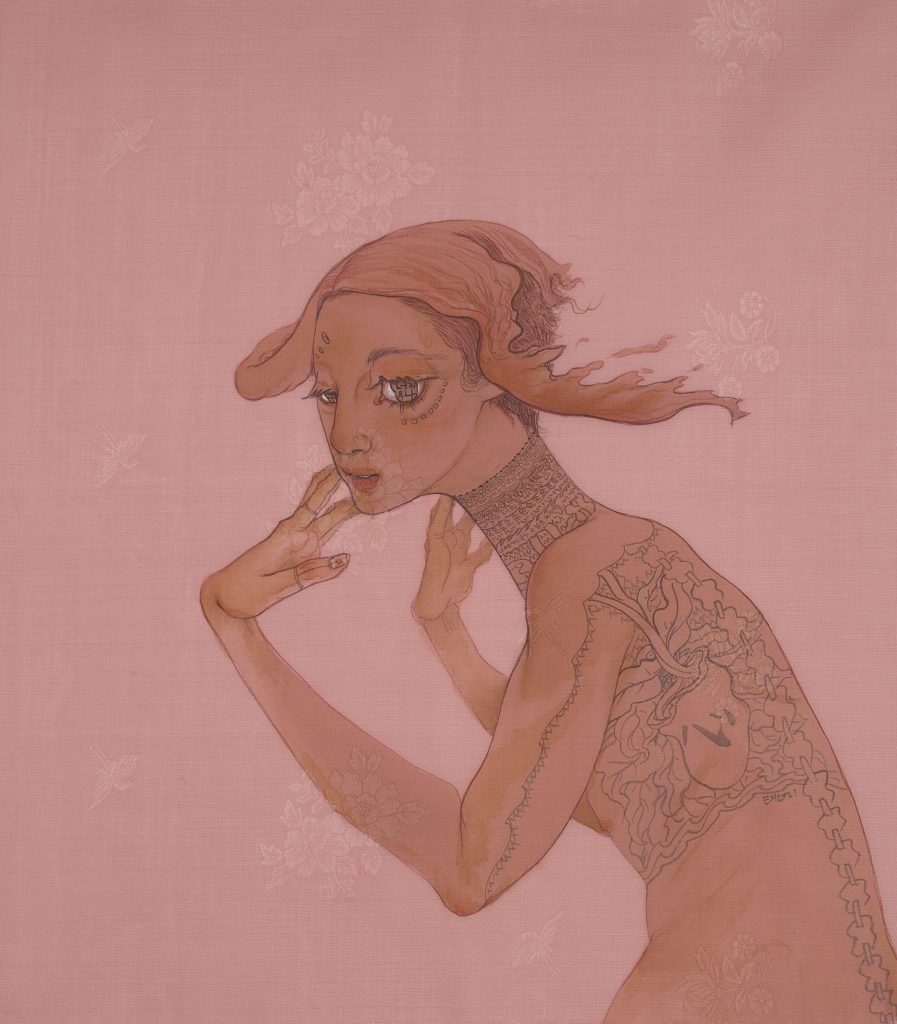
In your painting process, is it digital, on an easel or somehow else?
It depends but for my painting I work standing up. There’s a theory of strokes Pilsun in Eastern Asian brush technique and theory, where sometimes you have to hold your breath to paint. So, if I want to portray someone within a painting, I would have to hold my breath and that’s what I love about painting. It’s that whole thing about owning a person or trying to depict a person with my body.
I always want to try to work with technology that is readily available and very easy to reach. Which is why I talk about the Internet, and don’t go into media and game engine trying to make a video game. I’m more into the personal process and trying to capture someone’s soul. I hoard people I meet and in return I try to use my body as a vessel to go through it. It’s all about relationships for me.
If you have a real connection with the person online or via screen, you crave a physical interaction, no matter how impossible it is to actually touch them. Where does the relationship lie within the head or the body? That’s my question. How do people engage in this new world of relationships?
It seems fetishized?
That’s always present in the sub culture genre. And also…
Continued next week….
Read more in Trebuchet 11: Process
Featuring: Samuel Andreyev / Ed Atkins/ Nairy Baghramian / Phyllida Barlow / Peter Van Dyck / Oli Kellett / Tae Kim / Chris Levine / Gisela McDaniel / Paul Sietsema / Jeff Muhs
Tae Kim at Kristin Hjellegjerde Gallery

The aim of art is to represent not the outward appearance of things, but their inward significance. – Aristotle

